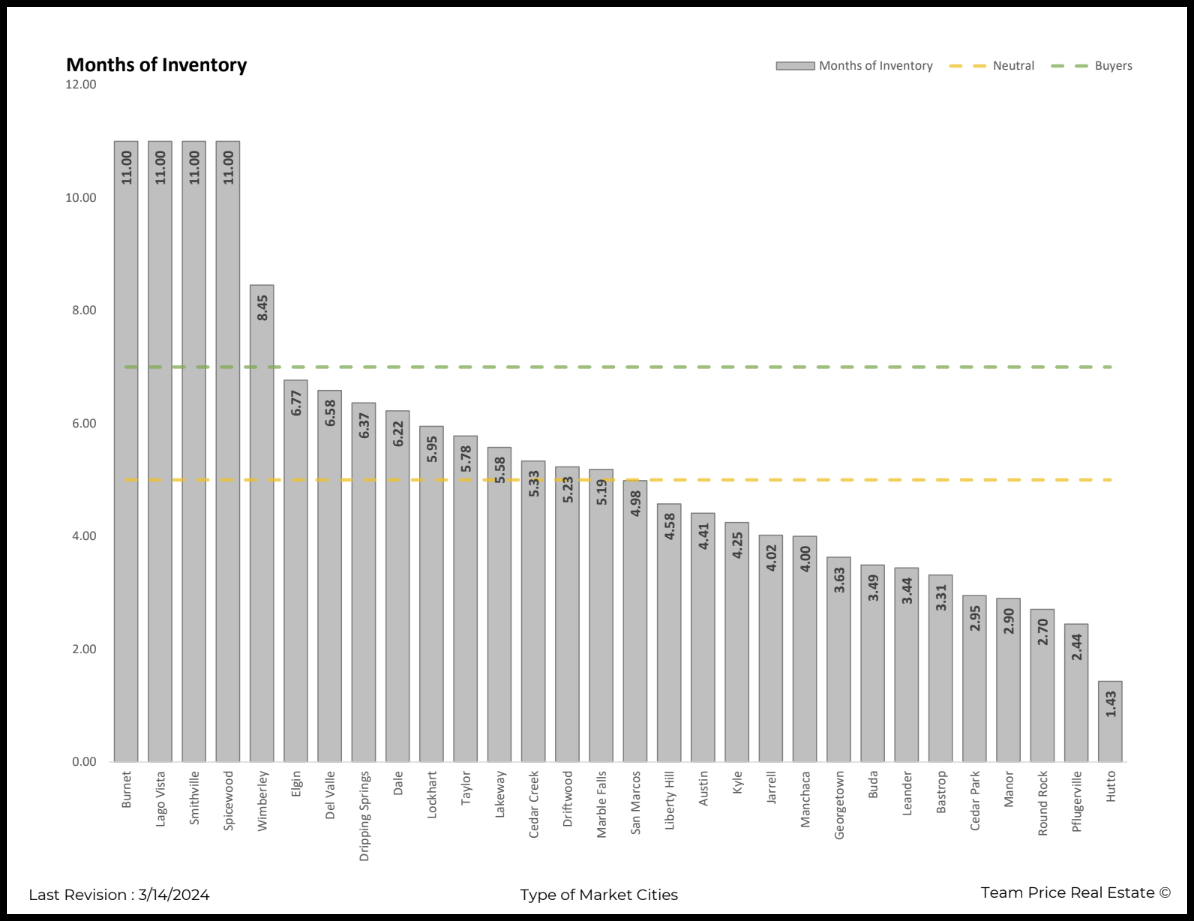Is Austin a Buyer or Seller Market?
In the landscape of real estate, understanding the market's current state is crucial for both buyers and sellers. One key metric that offers insight into this is the "Months of Inventory" (MOI). This figure represents the time it would take for all current homes on the market to sell given the current pace of sales. Analyzing MOI helps delineate whether we're in a seller's, neutral, or buyer's market. This article delves into the Austin real estate scene, dissecting the MOI across various areas to offer a comprehensive market update. The current analysis of Austin's real estate inventory reveals a diverse market, with significant variation across different areas. With an average MOI of 5.47, the broader Austin market appears to lean slightly towards a neutral market. However, this overarching figure masks the nuances of local micro-markets.
Seller's Market: Characterized by less than 4.9 months of inventory, a seller's market indicates a higher demand for homes than the supply can meet. In such markets, sellers often enjoy the upper hand, with multiple offers driving up property prices. Homes tend to sell quickly, and buyers must act swiftly and decisively to secure their desired property. About half of the analyzed areas, including Hutto, Cedar Park, and Manor, feature less than 4.9 months of inventory, categorizing them as seller's markets. In these locales, sellers enjoy a competitive edge, with properties often receiving multiple offers and selling above the asking price. Buyers in these markets need to make quick, competitive bids to secure homes. The following cities are currently experiencing a seller's market:
Austin (4.41 months)
Bastrop (3.31 months)
Buda (3.49 months)
Cedar Park (2.95 months)
Georgetown (3.63 months)
Hutto (1.43 months)
Jarrell (4.02 months)
Kyle (4.25 months)
Leander (3.44 months)
Liberty Hill (4.58 months)
Manchaca (4.00 months)
Manor (2.90 months)
Pflugerville (2.44 months)
Round Rock (2.70 months)
Neutral Market: Falling between 5 and 6.9 months of inventory, a neutral market strikes a balance between supply and demand. Neither buyers nor sellers have a distinct advantage, leading to more predictable pricing and a moderate pace of sales. This equilibrium allows for more negotiation room for both parties, creating a fair playing field. A significant portion of the Austin area, representing about a third of the market, falls into the neutral category. Areas like Driftwood, Liberty Hill, and San Marcos exhibit a balanced market dynamic. Buyers and sellers in these regions can expect a more measured transaction process, with neither party feeling pressured by extreme market conditions. Cities within this balanced market include:
Cedar Creek (5.33 months)
Dale (6.22 months)
Del Valle (6.58 months)
Driftwood (5.23 months)
Dripping Springs (6.37 months)
Elgin (6.77 months)
Lockhart (5.95 months)
Marble Falls (5.19 months)
San Marcos (4.98 months)
Taylor (5.78 months)
Buyer's Market: With more than 7 months of inventory, buyer's markets are characterized by a surplus of homes for sale. This scenario tips the scales in favor of buyers, who can leverage the higher inventory to negotiate better prices, terms, and conditions. Sellers may need to be more patient and flexible to attract offers. The analysis identifies several areas, including Lago Vista, Smithville, and Spicewood, as buyer's markets. These areas, with their extended inventory, offer buyers the advantage of choice and negotiation power. Sellers in these markets may need to adjust expectations and strategies to attract interest. The cities in the Austin area that are currently buyer's markets include:
Burnet (11.00 months)
Lago Vista (11.00 months)
Smithville (11.00 months)
Spicewood (11.00 months)
Wimberley (8.45 months)
Is Austin a buyer or seller market? Considering the average months of inventory across various areas, the Austin real estate market currently presents a nuanced picture. While the average leans towards a neutral market, individual neighborhoods vary significantly, ranging from seller's to buyer's markets. Buyers and sellers should consider local MOI data to understand the specific market conditions they're entering.
Conclusion : The Austin real estate market is diverse, with varying conditions across different areas. Understanding the current months of inventory is essential for navigating this complex landscape effectively. Whether you're buying or selling, a nuanced appreciation of local market dynamics can guide your decisions, ensuring you approach transactions with the right strategy and expectations. The Austin real estate scene offers opportunities and challenges, with market conditions fluctuating between seller's, neutral, and buyer's markets depending on the area. By staying informed and adapting to these conditions, participants in the Austin real estate market can navigate their transactions more successfully and strategically.
As of today, March 14th, 2024, the insights and analysis presented in this article reflect the current state of Austin's real estate market, capturing the nuances of the "Months of Inventory" across various cities. It's important to note that this information is dynamic, changing daily based on fluctuations in inventory availability and sales activities over the past 90 days. For those seeking the most current and up-to-date analysis of the market conditions by city, a wealth of resources and updates can be found at Type of Market: Navigating Central Texas Real Estate - In-Depth Insights for 30 Cities. Team Price Real Estate offers real-time insights, ensuring you have access to the latest data to make informed decisions in the ever-evolving Austin real estate landscape.








